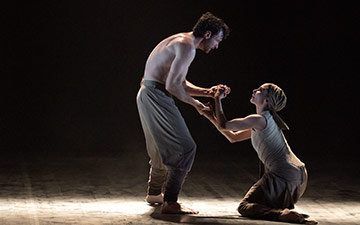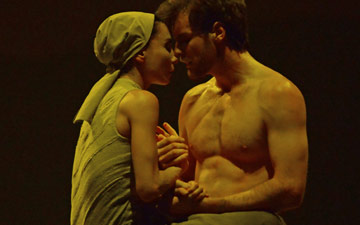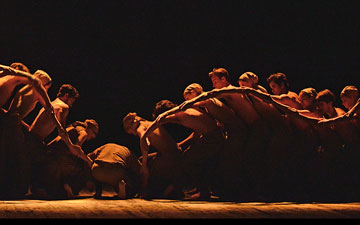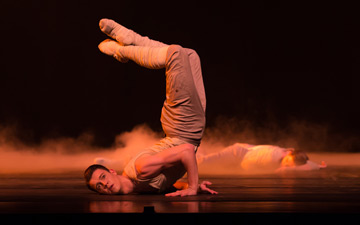
© Dave Morgan. (Click image for larger version)
English National Ballet
Lest We Forget: No Man’s Land, Second Breath, Dust
London, Sadler’s Wells
8 September 2015
Gallery of pictures by Dave Morgan
www.ballet.org.uk
www.sadlerswells.com
Surely the most memorable artistic contribution to the 2014 centenary of the First World War was the cumulative installation of ceramic poppies at the Tower of London. Beautiful and moving, whether viewed at the site or in images captured from above, the effect was even more emotive when The Last Post was played at sunset every evening. No words were necessary, apart from names read out from a Roll of Honour.
Could non-verbal dance and music be as powerful? That was implicit in the challenge Tamara Rojo, then the new artistic director of English National Ballet, set the three choreographers she commissioned to mark the centenary last year. (In fact, the premieres, presented at the Barbican in April 2014, took place before the poppies started being installed.) The programme, which won several awards for ENB, has been restaged at Sadler’s Wells before going on tour to Milton Keynes and Manchester.
Perhaps inevitably, the choreographers – Liam Scarlett, Russell Maliphant and Akram Khan – came up with similar ideas. They were bound to emphasise the experience of women during the Great War, since ENB’s large female contingent needed to be involved. Two of the pieces use archive recordings of soldiers’ voices; two use atmospheric clouds of dust. All are elegiac in tone, acts of remembrance rather than evocations of actual events. A brave experiment for the company in contemporary choreography but not ground-breaking for ballet as an art form.

© Dave Morgan. (Click image for larger version)
Scarlett has somewhat adapted his No Man’s Land since its first season, down-playing the munitions factory in which the women work at the back of Jon Bauser’s set. During the war, women packed explosives into bullets and artillery shells, which stained their hands bright yellow, giving them the nickname of ‘the Canaries’. The dancers’ yellow gloves are scarcely visible now, and the sulphuric powder has largely gone. Instead, the women have become ghosts or spirits in the minds of the men, who are phantoms themselves. No Man’s Land is a balletic vision scene, with a series of descending ramps like those in La Bayadère.
Though the ballet starts with the women howling silently, legs splayed in deep pliés, Scarlett’s vocabulary is not expressionistic. He has some vivid images – the women’s arms clutching the soldiers’ shoulder from behind like the straps of kit bags – but most of the choreography is neo-classical, swirling and yearning in pas de deux. Although he makes skilful use of stillness in the ensembles, his facility for attractive movement becomes indulgent. Liszt’s orchestrated piano pieces veer on the melodramatic, except for a plangent start to the final duet for Alina Cojocaru and James Forbat. She never meets his eyes, no matter how extravagant the lifts or how closely she is wrapped around his body. He is a ghost, she a wraith, representing a generation of lost lovers.

© Dave Morgan. (Click image for larger version)
Maliphant’s Second Breath is similarly sepulchral, with women (including Cojocaru again) seeming emanations of the men’s emotions. Michael Hulls’s lighting picks out upraised figures in sculptural formations before each soldier tumbles backwards into his comrade’s arms. It’s more formulaic than Maliphant’s work for his own dancers, with the corps of 20 or so rising and falling in slow-motion canon. Although Andy Cowton’s score includes a distorted recording of an old man’s voice recalling ‘the continual bombardment, all the time”, and then an extract of Dylan Thomas’s ‘Do not go gentle into that good night’, there is no rage or horror, only mourning for wasted lives.
Khan’s Dust tops the triple bill through the vividness of its imagery and the mythic power of its setting. A solitary sufferer (Fabian Reimair in Khan’s original solo, now shortened) is absorbed into a line of linked figures, their undulating arms more like ropes than the barbed wire of no-man’s-land. When they clap their hands, clouds of dust linger like poison gas. The wall of a trench rears up at the back, separating the departed soldiers from the grey-clad women below. Unlike Scarlett’s weary factory workers, these women are warriors, pounding the floor as lethally as the armaments machines they tended.

© Dave Morgan. (Click image for larger version)
They are anonymous in their defiance, shaking their fists, flaring their fingers and lunging around the stage to Jocelyn Pook’s vehement score. The piece becomes personal when a man (James Streeter) descends from the wall to join Tamara Rojo in a final duet of bereavement. When she performed it with Khan at the Barbican, they seemed mirror images because they were alike in height and supple fluidity: united as a single being, they were aspects of male and female, fighter and lover. With the much taller Streeter, Rojo is distinctly different, a burden and an inspiration – his reason for taking part in this war. When they become detached, it is as if he has lost his reason and therefore his life. He looks over the top of the wall at the abyss below, leaving her alone in the darkness.
Khan has taken ENB’s dancers in a new direction, finding ways of moving that don’t distort their classically-trained bodies while making them powerfully expressive. Dust, much tougher than the other two works in the programme, is the one likely to endure, justifying Rojo’s choice in commissioning him for her company.

















You must be logged in to post a comment.